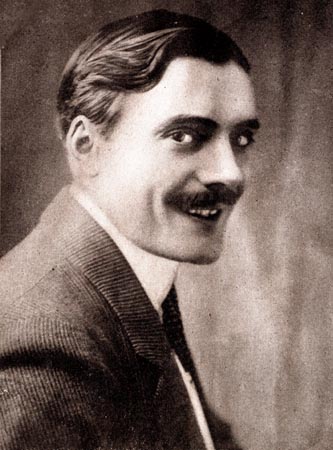
|
A short, elegantly coifed, mustachioed gentleman shuffles
into the room, a seemingly flawless and handsome example of
the French bourgeoisie in the early twentieth century. The
man, awkwardly shuffling, clumsily determined, dapper and
yet disarming, attempts to charm a lovely young woman, occasionally
succeeding.
One of the most successful comic actors of the silent film
era, Max Linder starred in several hundred films, most of
which he wrote and directed himself. In 1912, he was the highest
paid French actor in the world, making an incredible one million
francs that year.
In Republic of Images, Alan Williams refers to him
as “indeed the entire French cinema’s greatest
star of the prewar period." As David Cook explains in
A History of Narrative Film, Max “became world
famous for his subtle impersonation of an elegant but disaster-prone
man-about-town in prewar Paris." Despite his monumental
popularity on both sides of the Atlantic, today Linder is
relatively unknown to American film scholars and aficionados
alike.
Max Linder was born Gabriel-Maximilien Leuvielle on December
16th, 1883, in the small village of St. Loubes, Gironde, in
Bordeaux, France. His parents were grape farmers who supplied
many wine manufacturers and controlled a large vineyard, and
they wanted nothing more for Max than what he already knew,
but a career in grapes was the last among his goals. Max showed
an early penchant for the stage, and as a teenager he enrolled
in the Bordeaux Conservatory where he studied drama, eventually
performing in local theatre productions.
Max was doing what he loved, but he longed for the spotlight,
and a larger audience was necessary for his star to rise in
the way he knew that it would. While working at the Ambigu
theatre after moving to Paris in 1904, Max dropped his birth
name and started calling himself Max Linder.
While continually attempting to pass the entrance exam for
the Paris Conservatory (he failed the test at least three
times), Max landed his first roles via the extras casting
coordinator at the Ambigu, Louis Gasnier, who also happened
to direct films for Pathé, and quickly took a liking
to young Max and cast him in his first film, La Premiere Sortie
d’un collegien, or The School Boy’s First
Outing, in 1905.
Things appeared to be changing dramatically for Max when,
in 1907, he was chosen to fill a role made popular by a successful
comic actor known simply as Grehan after he left for another
studio. Williams states, “Linder was chosen to fill
Grehan’s shoes, as well as his evening coat, dress shirt,
and tie. Assuming the costume and much of the manner of Grehan’s
character ‘Gontran,’ Linder made, under Gasnier’s
direction, Les Debuts d’un patineur/Max Learns to
Skate (1907), the first work in which he becomes, recognizably,
‘Max’." Unfortunately, neither the real
Max nor the Max character made much of an impression, though
Linder stayed on with Pathé and worked on other projects.
Two years later, in 1909, Max reprised his version of Grehan’s
Gontran, and all of a sudden he was a star. Between the years
of 1909 and 1914, Max Linder made a film almost every two
weeks, and he rocketed into the position of the first real
international star of the cinema. According to Williams, “He
made tours of Spain, Russia, Germany, Eastern Europe. Everywhere
he was mobbed. Women were said to contemplate suicide at the
thought of his inaccessibility."
Max created one of the most memorable stage presences the
cinema had known in its short history. Most of his films,
as stated on the website Collector’s Homepage, “revolved
around the blameless bachelor Max who lives in luxury and
gets into funny situations because he is after a well-behaved,
pretty young lady."
Unlike some of his successors, like Mack Sennett, who relied
on an overt, exaggerated or a more “slapstick"
comic style, Max, according to Rick DeCroix in his article
“The Man in the Silk Hat," “specialized
in a more refined and subtle comedy mode. An early practitioner
of situation comedy, his films invariably concerned the uprooting
of social expectations and mores." In other words, Max
relied upon more reserved gestures and expressive facial expressions
than some of his contemporaries who pandered more overtly
to the camera. As Williams has commented, “Broad slapstick
would in any event have been out of place with the Max character,
a distracted bourgeois dandy played with a real sense of what
it meant to belong to the bourgeoisie."
A sort of all-purpose and moderately successful character
actor, once Max stepped into his version of Grehan’s
likeable, clumsy dandy, he had found his niche and never looked
back; Linder could easily be called the father of typecasting,
though he didn’t seem to mind. As the website Mugshots
argues, he “exemplified the French ideal of joie de
vie, always coming up smiling no matter what disaster befell
him."
The key to Max’s international, cross-cultural, and
class-transcending fame was his ability to make different
people laugh for different reasons. Though Max was always
impeccably dressed in the requisite tuxedo and tails, with
a top hat and a cane, all clear signifiers of the aristocracy,
his bumbling antics could interest anyone from a tramp to
a duke.
Linder had a real talent for holding the viewer’s attention
and making the most out of minimal sets and plots. In “Laugh
with Max Linder," Mark Zimmer explains that Max was
always “willing to milk a situation for all its worth
and then change locales to set up the next set of gags."
The bourgeoisie could laugh at him for being a misdirected
one of their own, constantly managing to get himself into
difficult and amusing situations, like in Le Chapeau de
Max (1913) when he is invited to a formal dinner, and
has an impossibly difficult time selecting and retaining the
perfect hat for the occasion, or in Seven Years Bad Luck
(1921), when Max breaks a mirror, and despite spending the
rest of the film attempting to avoid situations which would
cause him trouble, he still brings the worst kind of luck
upon himself. This film, one of Max’s most famous, features
a scene in which Max mimics himself in a mirror, a difficult
technical marvel that, filmed with a double, took an incredible
amount of time to rehearse, but some viewers still think of
it as the first and the best “broken mirror" scene
ever filmed. Zimmer comments, “Particularly notable
is the early sequence where his valet (who originally broke
the mirror himself) sets up the cook to mirror Max’s
every move in the frame. This gag was of course picked up
by others such as the Marx Brothers, but it’s fluently
pulled off here, with exquisite timing and very long takes
that must have required a great deal of effort to achieve."
Bourgeoisie viewers could relate to the situations and laugh
at Linder’s impropriety and inability to assimilate
properly, while working class and other viewers could simply
laugh at Linder’s good natured buffoonery, his character’s
tendency toward the bottle, and his weakness for attractive
young ladies. As Williams reminds us, most of Max’s
humor “springs from the conflict between Max’s
extreme self-confidence, as aspect of his social position,
and his incompetence at even the simplest tasks."
Linder influenced everyone from Mack Sennett, Buster Keaton,
Harold Lloyd, and Charlie Chaplin to Fatty Arbuckle, Abbot
and Costello, and The Three Stooges. “Although he expanded
and developed Max’s comic persona, Chaplin would borrow
virtually intact Linder’s restrained, minimal methods
in using the film medium, " Williams states. Indeed,
Chaplin paid homage to Linder on several occasions, both referring
to him as “my professor," as DeCroix explains,
and, according to the Collector’s Homepage, dedicating
at least one of his films to Max with this tribute: “For
the unique Max, the great master—his student Charles
Chaplin."
By 1910, Linder had been writing and supervising, and by 1911
also directing, all his own films. His popularity was at its
peak in 1914, when he went to war. Linder fought in the French
army for two years of World War I, and afterward his career
was never the same. He had been a victim of a German poisonous
gas attack, and his already slight constitution was irreversibly
affected. He returned briefly to French films, but finding
his popularity vanishing, he accepted an offer from Essanay
and moved to the US in 1916.
Continuous bad health affected the American phase of his career.
In mid-1917, after only three films, he got double pneumonia
and spent nearly a year recovering in a Swiss sanitarium.
When he returned to the US in 1921, he formed his own production
unit, releasing through United Artists. But after making only
three more American films, including the famous parody of
Fairbanks’ The Three Musketeers, The Three
Must-Get-Theres, he returned to Europe, where he married
the seventeen-year-old daughter of a Paris restaurateur in
1923, Jean Peters. Max was forty-years-old. Soon thereafter,
by many accounts, Max was sinking into a deep depression,
dealing with his fading stardom and his ill health.
In 1925, Max and his young bride poisoned themselves and slit
their wrists, leaving an infant daughter behind. Nearly forty
years after Max’s shocking death, his daughter, Maud
Linder, started a campaign to bring her father’s legacy
back to light. In 1963, Maud Linder wrote and directed a film
tribute to her father entitled En Compagnie de Max Linder,
also known as Laugh with Max Linder or Pop Goes
the Cork. This pseudo-documentary, nearly impossible
to find, was narrated by the legendary filmmaker, René
Clair, and features many clips of the great Linder, in his
element. However, the film received little attention, and
according to many critics, her efforts only deepened the mystery
surrounding the premature death of one of silent cinema’s
great artists.
Maud Linder was not satisfied with her work, and twenty years
later, she decided to make another attempt to honor her late
father on the big screen. In 1983, she released L’Homme
au chapeau de soie, or The Man in the Silk Hat.
This time Maude Linder wrote, directed, and narrated her documentary,
but to no avail. Though her second effort would not slip into
obscurity just as easily as her father or her previous film
had, it too received little notice, though cult fan groups
hoard it as the only “documentary" available on
the elusive Max. Unfortunately for those who wish to know
the real man, those who appreciate the truth, The Man
in the Silk Hat answers precious few tough questions.
As DeCroix tells us, “The Man in the Silk Hat
is a film with one main purpose: the resurrection of Max Linder’s
position in the film comedy pantheon. Obviously, it is a labor
of love, and therein lie certain obstacles. Always striving
to fulfill its goal, this documentary celebrates rather than
investigates. We learn much of Linder’s engaging screen
presence but little of his tormented private life."
DeCroix’s call for investigation is not unwarranted
but none have answered it. Few film scholars disagree with
the placement of Max Linder near the top the catalog of talented,
influential, and beloved comic actors, but his daughter’s
films seems to leave us wanting more. According to Maud herself,
“There was no real explanation for this tragedy [the
double suicide] and I never tried to find one."
Max Linder is compelling because of his talent and because
of his personal story. He rose from modest beginnings as a
grape-farmer’s son to become the greatest movie star
the world had ever known. He fought for his country, slowly
slipped in popularity, and died a shocking, mysterious death.
His films appealed to just about anyone who liked the cinema,
he influenced some of the most famous comedians of all time,
and now, shockingly, tragically, he is largely unknown.
November 2004
From guest contributor Chris Driver
|



